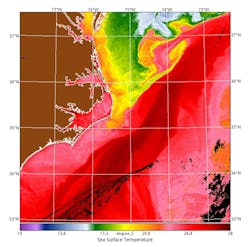Military researchers ask industry for new ocean circulation models using remote sensor data and algorithms
ARLINGTON, Va. – U.S. military researchers are asking industry for improved ocean circulation models to prevent enemy tactical or strategic surprises during conflicts.
Officials of the U.S. Defense Advanced Research Projects Agency (DARPA) in Arlington, Va., issued a request for information (DARPA-SS-24-02) last week for the Advancements in Ocean Modeling and Monitoring project.
Knowledge of real-time ocean dynamics is essential but is today hampered by lack of data and information on which to base military models and assessment -- particularly in the ocean interior, DARPA researchers explain.
The Advancements in Ocean Modeling and Monitoring project seeks to understand how to monitor the ocean and model its dynamics across a variety of spatial and temporal scales.
Today's best military ocean models involve sonar and radar propagation estimation, search and rescue optimization, ocean sea-state forecasting, weather forecasting, and decadal climate and sea level change predictions.
Today's ocean models, however, rely on relatively sparse sensor data that come from sources like profiling floats, stationary moorings, unmanned underwater vehicles (UUVs), sea gliders, and irregular research ship expeditions.
Ocean modeling suffers from data sparseness, poor time resolution, and data shallowness with little characterization of the deep ocean. Accurate and well-calibrated characterization of the ocean interior, including salinity, temperature, pressure, and ocean current velocity, is necessary for decreasing the uncertainty of ocean models, sea state forecasts, and terrestrial weather forecasts.
From industry, DARPA researchers are asking for information on advances in ocean circulation modeling. Of particular interest are measurements, algorithms, and models that enable fundamentally new understanding of U.S. ability to simulate, forecast, and understand ocean processes across several different time scales.
Related: Keeping a watchful eye on Earth observation and weather forecasting
Key challenges include technologies to enable widespread characterization of ocean parameters involving sensors, remote sensing, algorithms, communications for real-time data collection, and remote sensor maintenance.
DARPA researchers want to learn about recent innovations to improve the resolution and accuracy of modeled ocean dynamics; ways to include uncertainty in input parameters or model output; innovations to improve the predictive capabilities of long-term ocean model forecasting over years; and ways to integrate high-resolution data into ocean models that can update in real time to enable improved weather and ocean forecasting.
Companies interested should email responses no later than 7 Oct. 2024 to [email protected]. Email questions to concerns to DARPA at [email protected]. More information is online at https://sam.gov/opp/3af6a582e58a455499410b7cf7dcc167/view.
About the Author
John Keller
Editor-in-Chief
John Keller is the Editor-in-Chief, Military & Aerospace Electronics Magazine--provides extensive coverage and analysis of enabling electronics and optoelectronic technologies in military, space and commercial aviation applications. John has been a member of the Military & Aerospace Electronics staff since 1989 and chief editor since 1995.
